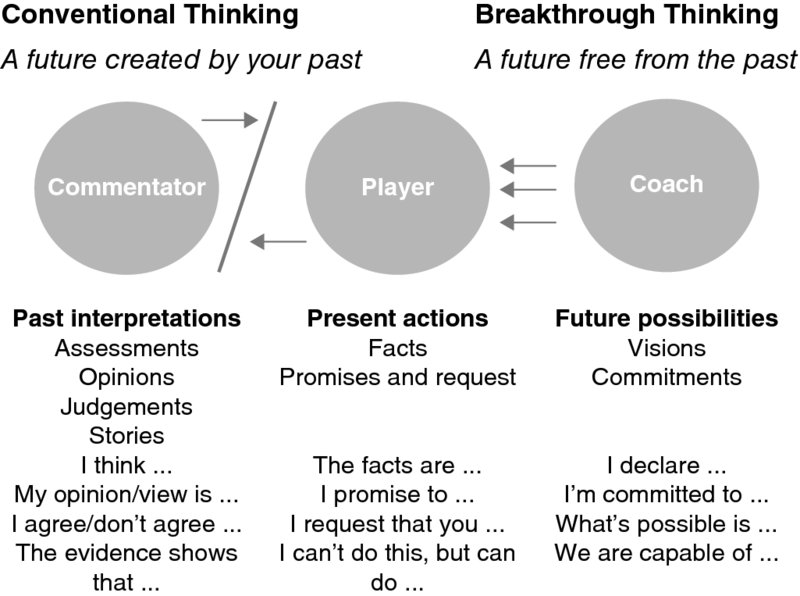Shift 6
KEEPING THE ORGANIZATION FUTURE-FOCUSED

To keep the organization future-focused, you need to create structures that ensure the new aspirations can be achieved.
Know the power of conversation
It is critical to understand the true power of conversation.
There is a common belief among individuals and society that “talk is cheap”, and we have probably all heard the phrase “actions speak louder than words”. The fundamental assumption here is that “what you say doesn’t really matter”, because action is what matters. This is a fallacy. How we talk and listen determines both our actions and the actions of the people around us. Action follows the way we speak, listen and think.
“How we talk and listen determines both our actions and the actions of the people around us.”
A good example is that of a sales convention held by a well-known global FMCG organization. Picture a professional stage, dry-ice, big music and theatrical introductions. Then add a high-energy speech from the Sales Director encouraging his teams to strive for 50% growth with the promise of better cars, bigger bonuses and slick new phones. Naturally, the sales teams are highly motivated, and there is positive energy buzzing and momentum built around this breakthrough target.
Later on that day, during evening drinks, the Sales Director lets it slip that in fact, “10% growth would be just great, guys”. This smashes the context that had been built up earlier and constructs a new reality – “10% is what is really expected”. Sure enough, at the end of each quarter over the next 12 months, the sales for that year were re-forecast. The company delivered 9% sales growth.
It’s obvious that words matter – what a leader says can lead to an unintended consequence inconsistent with the results you want. For example, comments after a difficult conversation with a colleague or reflections on their own levels of possibility for the company.
What people say creates reality. For example, when the boss says, “You are fired” you experience a major shift in your reality; just as when the vicar says, “You are married” – or a Prime Minister says, “We are at war”. Consider the reality that you want to build in the minds of your people – do your words reflect your ambitions? Let’s consider an example of a negotiation, if you were selling an item for £100 and were committed to getting this, then you would need to act consistently with that objective. In this example, if you discuss the price with a potential buyer and receive a counter-offer and you change your price expectation to bridge the gap, the buyer will immediately know that you have shifted once and there is a high probability that you will do so again. The negotiation will continue. The lesson here is even when you are making a stand for change, once you shift, people will think about compromise and how they can bridge the gap between today’s reality and tomorrow – your vision immediately starts to be diluted.
“What people say creates reality.”
A leader’s role and what that leader says are pivotal in training teams to speak and think from the future. Consider typical conversations held at a major sporting event, such as a football match. There is a key difference between the conversations of the commentators and the conversations the coach has with the team.
Leaders need to consider themselves as the coach; always thinking about how to get the best out of their team. They should be having conversations about how to win and how to move the game forward, not being influenced by conversations at the sidelines, speculation and general commentary.
In organizations, minute by minute, moment by moment, we are either commentating on some kind of mediocrity based on the past or coaching ourselves to some kind of future we want. These are two fundamentally different paradigms, as illustrated in the following diagram.

Action follows both commentating and coaching. However, coaching conversations produce fundamentally different actions. When someone has a new project or initiative, people will often give you a commentary on why it is difficult to accomplish. This is only natural. Yet the action that people take in the face of this commentary generally leads to continuous improvement, but not extraordinary results.
Interestingly, a number of studies have indicated that a large proportion (>80%) of conversations in the Western world are based on commentating not actions and possibilities.
Make strong commitments
Leading your organization to remain in a future that is liberated from the past also involves making strong commitments and declarations about current and future actions.
WHAT DO COMMITTED PEOPLE SAY AND DO?
People who are committed to achieving breakthrough results hold a different kind of conversation, following the principles outlined below:
| Conventional Conversation | Breakthrough Conversation |
|
|
People who are committed to a future free from the past will avoid having conversations based upon assessments, opinions and justifications. Instead, they will typically make statements such as:
- “I’m committed to …”
- “What’s possible is …”
- “We are capable of …”
Commentators can be a power force field in an organization – to such an extent that a company strategy or desired direction freezes. The situation often leads to an organization being very busy but with little or no alignment or focus; basically standing still and remaining in a static or frozen state – often described as stability. The bigger an organization or company becomes, the more likely this situation will arise.
“As the fear of loss is generally greater than the desire for gain, staying in the frozen state requires little convincing.”
Different work environments can be more effective in gaining an organization’s alignment and focus in delivering a new and exciting vision. However, often the organization will need to be unfrozen to enable progress. In a frozen state the commentators play a lead role in expressing all the risks associated with any proposed change. As the fear of loss is generally greater than the desire for gain, staying in the frozen state requires little convincing.
UNFREEZING AN ORGANIZATION
Consider when a company is acquired, a school is integrated with an adjacent district or county, or a hospital is transferred under the management of a new healthcare trust. In these situations the organization becomes unfrozen and during that time will be more accepting of change.
Now let’s take this matter a little deeper and consider an acquisition that involves all or part of a business moving under the new ownership.
On the day the organization is acquired and the name above the main entrance is changed, this does not constitute an immediate change of behaviour, mindset or a new way of working. However, it is one event that initiates the unfreezing of the organization. Speculation about the future begins and staff start to build a future in their minds based on the limited and often inaccurate information they have to hand. Whether the change involves a large or small organization a similar situation generally occurs.
The organization now starts to unfreeze and prepare itself for a change based on personal insights and opinions of staff. Few organizations take the opportunity during a period when an organization is unfrozen to make significant changes, yet staff are preparing themselves for a different world.
“Few organizations take the opportunity during a period when the organization is unfrozen to make significant changes, yet staff are preparing themselves for a different world.”
Initially when a company is acquired management may create a bold vision set between executives and key management. It is relatively easy at this point in time to be optimistic; however, as time progresses conditions and constraints begin to influence management’s thinking. The need for an easy life creeps in. Commentators see all the risks.
Significant opportunity can be missed, as staff are expecting something different to happen and generally their expectations go way beyond what is finally planned. Staff continue to build a picture in their mind of a new state following change, talking at coffee machines and building on each other’s views and opinions. In most cases they are not informed sufficiently and therefore their thinking is not constrained by any real constraints.
In these situations, the worst is feared or the best assumed and staff are prepared for the extremes. In the meantime, management is working hard to minimize disruption, tighten controls and avoid risk.
There quickly becomes a misalignment of expectations, which can cause delays and relatively poor results. This is a period when cool heads with ambition and fresh thinking can create a platform for rapid change, building organizational muscle on the journey to a new and more dynamic business model.
Whilst management fear instability, they are also concerned about putting their business with customers at risk. It is important that management do not underestimate the capability of the organization to keep the wheels of the business turning. The risk is likely to be lower than perceived. Business routines will continue; the paradigm is strong and it naturally creates sustainability in the day-to-day requirements for servicing its customers.
The risk associated with poor ambition of management is that the organization freezes again. If the organization freezes, it can be a 12-month process to create an environment that provides a similar context for change.
“You can’t connect the dots looking forward; you can only connect them looking backwards. So you have to trust that the dots will somehow connect in your future. You have to trust in something - your gut, destiny, life, karma, whatever. This approach has never let me down, and it has made all the difference in my life.”
Steve Jobs